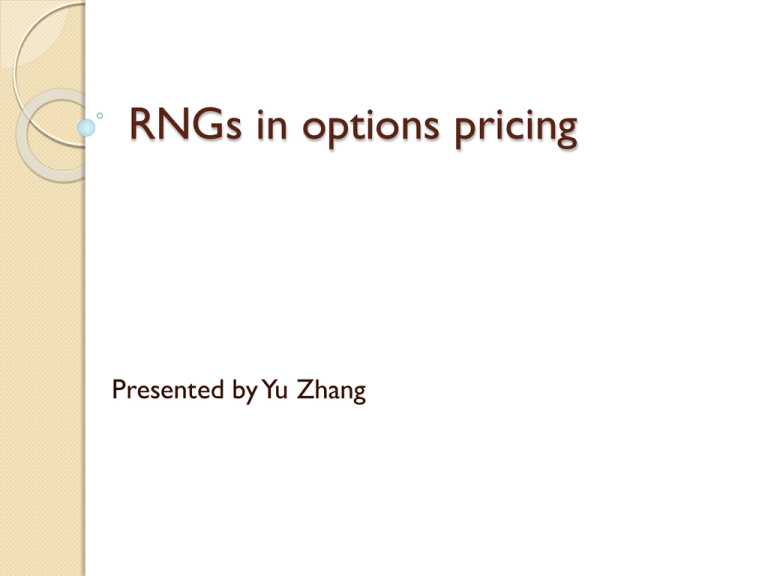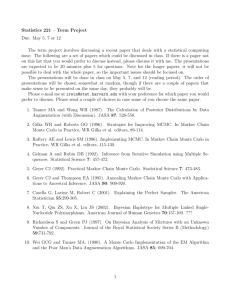RNGs in options pricing
advertisement

RNGs in options pricing Presented by Yu Zhang Outline Options What is option? Kinds of options Why options? Options pricing Models Monte Carlo Methods Apply to European options Disadvantages Speed up Least-Squares Monte Carlo method Quasi-Monte Carlo methods Option? Option maybe a good choice. Option[1] Call options: gives the holder the right, but not the obligation to buy the underlying, S, at a certain date, T, for a certain price, known as the exercise (or strike) price, X. C(S, T)=max(S-X, 0) Put options: gives the holder the right, but not the obligation to sell the underlying, S, at a certain date, T, for a certain price, known as the exercise (or strike) price, X. P(S, T)=max(X-S, 0) Kinds of options European options: can only be exercised at the expiration date T. American options: can be exercised at any Asian options: the strike price is the average time up to and including the expiry date, T. So, it is much more difficult to value. price of the asset over a period of time, computed by collecting the daily closing price over the life of the option. Why option? Options for hedging Options for speculating What determine the value of options The value of an option,V, is determined by: The granted price (strike price), X. The current price, S. The time to the expiration date, T. The volatility of the underlying asset, . The annual rate of return for risk-free investment, r. Option pricing models The Black-Scholes Only can be used for pricing European options, because it does not have the flexibility to calculate pricing of options that are exercised early. (Fastest) Binomial Tree Memory-intensive because it requires an iterative computing process. Monte Carlo models flexible computational tools to calculate the value of options with multiple sources of uncertainty or with complicated features. The Monte Carlo method was first suggested as a way to price options in 1977 by Phelim Boyle in his paper: “Options: A Monte Carlo Approach”[2] Monte Carlo Method With the Monte Carlo technique, we try to evaluate the value of E[f(YT)]. (Expectation of a function of a random variable) 1 N N lim f (Y ) E[ f (Y )] N n 1 n T The quality of the random number generator typically determines the quality of the simulation. Apply to European call options Get n trajectories of the form St+1, …, ST, where each period corresponds to one quarter. Path 1: S1t+1, S1t+2, …, S1T Path 2: S2t+1, S2t+2, …, S2T … Path n: Snt+1, Snt+2, …, SnT St t St exp[( r 2 / 2)t t Z ] where Z is a standard random variable, i.e. Z~N(0,1). Apply to European call options Get n terminal values V(ST) V ( STn ) max( STn X ,0) Apply to options European call options V ( ST , t ) e r (T t ) 1 N N n V ( S T) n 1 Average the cumulative results and discount the value to the present to get an estimate for the value of the option. Here, the principle of the time value of money is used. For example, if you want to receive $100 at T, then at an earlier time t it is worth $100e-r(T-t). r is the compound rate. Disadvantage Requires running many simulations based on random series of events, so it is the most timeconsuming. The convergence of Monte Carlo methods is slow and it is hard to determine the error terms. Speed up[3] Speed up Box-Muller Random Number Generator a simulation core that provides computational resources for iteration, a stochastic volatility computing module based on the GARCH* model a post processing module. e.g. for averaging intermediate option prices. GARCH* is a model for error variance, which is widely used in Financial Forecast. Apply to American options[4] The optimal exercise strategy is fundamentally determined by the conditional expectation of the payoff from continuing to keep the option alive. Monte Carlo simulation for an American option has a “Monte Carlo on Monte Carlo” feature that makes it computationally complex. Least-Squares Monte Carlo method[5] At each exercise time point, option holders compare the payoff for immediate exercise with the expected payoff for continuation. If the payoff for immediate exercise is higher, then they exercise the options. Otherwise, they will leave the options alive. The expected payoff for continuation is conditional on the information available at that time point. LSM After get the option value V, we perform regression of V as a function of the polynomials X, X2, …, Xm for some small value of m which is called basic function; i.e. approximate Vk by a least squares fit of these polynomials in X. Hence we use this regressed value in deciding whether to exercise early. It performs better than other Monte Carlo methods in high dimensional cases. Quasi-Monte Carlo[6] The use of low discrepancy sequences (Sobol sequences) in Monte Carlo method leads to what is known as quasi-Monte Carlo method. Advantage: It is more accurate than traditional Monte Carlo methods, and has better convergence property. QMC simulations are well suited to parallel computing. So, it can provide rapid solutions for financial market. Quasi-Monte Carlo vs. Monte Carlo The accurate value of the option is 22.772, which was computed using a finite difference lattice. Parallel QMC algorithm[7] Result of parallel algorithm References [1] Random numbers in Financial Mathematics:Valuing Financial Options. Peter Duck, University of Manchester, ENGLAND. September 11, 2007. [2] Options: A Monte Carlo approach. Boyle, Phelim P. Journal of Financial Economics, 4 (1977), P 323-338. [3] Design and implementation of a high performance financial Monte-Carlo simulation engine on an FPGA supercomputer. Xiang Tian Benkrid, K. ICECE Technology, 2008. Dec. 2008, P 81-88 [4] Pricing American Options using Monte Carlo Methods. Johan Tysk. Jun 2009. Department of Mathematics. Uppsala University. [5] Valuing American Options by Simulation: a Simple Least-Squares Approach. Longstaff, F. A., Schwartz, E. S., 2001. Review of Financial Studies 14 (1). [6] Multi-asset derivative pricing using quasi-random numbers and Monte Carlo simulation. George Levy, Numerical Algorithms Group. Oct. 2002. [7] Distributed Quasi-Monte Carlo Algorithm for Option Pricing on HNOWs Using mpC. Gong Chen Thulasiraman, P. Thulasiram, R.K. Simulation Symposium, 2006. 39th Annual, 2-6 April 2006. Thanks~




